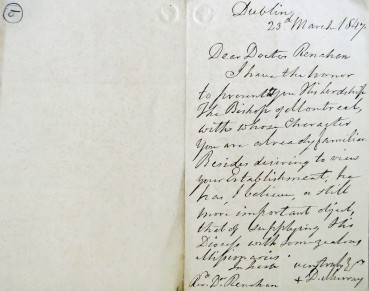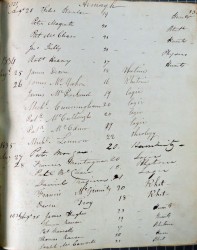Document of the Day: By Professor Christine Kinealy, Quinnipiac University and Dr Jason King, Irish Heritage Trust, and Irish National Famine Museum

In late summer 1845, newspapers throughout Europe carried reports of a previously unknown disease that was destroying the potato crop from Belgium to England. On 13th September, the London newspaper the Gardeners’ Chronicle and Gazette announced:
“We stop the presses with great regret to announce that the potato murrain has unequivocally declared itself in Ireland. The crops about Dublin are suddenly perishing. Where will Ireland be in the event of a universal potato rot?”
Almost 50 per cent of the Irish population depended on potatoes as a diet staple. At this stage, no one expected that this mysterious disease would reappear, in varying degrees of deadliness, for a further six years. In the first year of shortages, despite widespread suffering, there were no deaths from starvation but by the end of 1846, disease and death were evident throughout Ireland.

The Great Hunger proved to be one of the most devastating humanitarian disasters of the 19th century. In only five years, Ireland lost about a quarter of its population through a combination of death and emigration. Sadly, in addition to those who died in Ireland, a large number died en route to their destination, or shortly after arriving there. Between 1846–51, as many as 1.5 million people left Ireland, never to return. Passage to Canada (also known as British North America) was a favourite destination for Famine emigrants. If emigration started as a voyage of survival, for thousands it ended in disappointment, with as many as 10 percent of people not making it to the new world. Many more, weakened by the long voyage, perished shortly afterward. Two areas that felt the full impact of the Famine exodus were Grosse Isle and Montreal, both in Quebec. Grosse Isle, located in the Gulf of St. Lawrence, had been established as a quarantine station in 1832. In 1847, it was the first landing place of Irish refugees, with an estimated 100,000 Famine emigrants arriving there. More than 5,500 people died on the island, primarily of typhus fever. As a consequence, Grosse Isle, along with Montreal, became the largest burial grounds for victims of the Great Hunger outside Ireland.
Montreal was the main Canadian port of debarkation for Famine immigrants. In 1847 alone, 75,000 Irish emigrants landed in this city of 50,000 people, mostly in the summer months. A large portion of them were sickly or dying, many being afflicted with typhus fever. To cope with this unprecedented influx, twenty-two new fever sheds were erected along the waterfront. A number of religious orders, including the Grey Nuns, worked tirelessly to help the ailing. Regardless of the sacrifice and the efforts of these women, thousands of poor Irish died in the sheds, their time in Canada proving all too brief. As many as 6,000 Famine immigrants perished in Montreal.

An exhibition exploring the little known story of the Grey Nuns and other religious orders in Montreal, who provided care and shelter to Irish immigrants in Canada during the Great Hunger, is currently running in the Russell Library at Maynooth University. ‘Saving the Famine Irish: The Grey Nuns and the Great Hunger’ was curated by Professor Christine Kinealy, Director of Ireland’s Great Hunger Institute at Quinnipiac University, and Dr Jason King. The exhibition tells the story of the religious and clergy who cared for Irish emigrants in the fever sheds of Montreal during the summer of 1847. One of the first priests to enter the fever sheds with the Grey Nuns was Father Patrick Morgan, who was ordained at Maynooth College in May 1842. Morgan was born in Collon, Co. Louth, in June 1810. Following his studies at Maynooth, he joined the Paris-based order of the Priests of St Sulpice on 3rd September 1842 and arrived in Montreal on 24th September 1843. Morgan was the first priest to enter Montreal’s fever sheds with the Grey Nuns in June 1847. He was also one of the first clergy to perish from the typhus epidemic, dying on the 8th July 1847. The current exhibition features the matriculation entry for Father Patrick Morgan and a letter of introduction for Montreal’s Bishop, Ignace Bourget (1799-1885), who visited Maynooth in 1847 to recruit Irish missionary priests.

The exhibition ‘Saving the Famine Irish: The Grey Nuns and the Great Hunger’ is running in the Russell Library, Maynooth University, until 25 January 2018. For further details:
https://www.maynoothuniversity.ie/library/events/saving-famine-irish-grey-nuns-and-great-hunger